List of natural forest reserves in Lower Saxony
The list of natural forest reserves in Lower Saxony contains 107 (as of March 2017) natural forest reserves in Lower Saxony . The list contains the official designations for name, identifier, natural area , size and the year of designation. The geographical location is averaged and the information about the district / city relates to this information. However, the areas can also extend over several administrative districts.
For about 40 years (more since the nature conservation year 1970), natural forest reserves have been designated throughout Germany in order to preserve a range of total reserves. Natural forest reserves are forests that are largely in a natural state. The natural forest development takes place here undisturbed. In the course of time, primeval forests with strong trees and a lot of dead wood develop there . In Lower Saxony there are currently 107 such natural forest reserves with an area of 4576 hectares.
| Name of the area | image | Identifier | Natural space | District / City | Description / remarks | Location | Area in hectares | Year of regulation |
|---|---|---|---|---|---|---|---|---|
| Ahlershorst |

|
03-132 | Stader Geest | District of Cuxhaven | The natural forest consists of two sub-areas on a moderately humid location with a moderate supply of nutrients, e.g. Some with a light moor layer. The natural forest community is a transition from the common oak-beech forest to the common oak-hornbeam forest, whereby the aspects of the common grass-beech forest predominate. The entire natural forest area is historically old forest. | position | 4.5 | 1996 |
| Ahlhorn fish ponds |

|
03-131 | Dümmer Geest lowlands and Ems-Hunte-Geest | District of Oldenburg | Alder and ash forests of the floodplains and spring areas with pronounced flooding dynamics, predominantly developed in a near-natural manner, on predominantly base and nutrient-poor locations with vegetation adapted to them. | position | 18.6 | 1998 |
| Allerauenwald in Drömling |

|
03-151 | Weser-Aller lowlands | District of Helmstedt | The aim of the natural forest designation is the development and protection of an alluvial forest under optimized water conditions. | position | 99.2 | 2011 |
| Old enclosure |

|
03-032 | Lueneburg Heath | District of Uelzen | Mixed deciduous forest of beech, English oak, hornbeam, alder, ash and other tree species in different mixtures on small-scale, strongly changing locations with differentiated ground and backwater influence. In the development area south of the road, which was integrated in 2000, also red alder on spring moor. | position | 23.9 | 1972 |
| Barenberg | 03-130 | Dümmer Geest lowlands and Ems-Hunte-Geest | District of Cloppenburg | Extremely weak growing pine and mixed pine stands on sometimes extremely poor and dry sandy locations. Pronounced terrain relief with inland dunes up to 2 m high. Partial areas since 1950 without management. | position | 10.4 | 1997 | |
| Barnbruch |
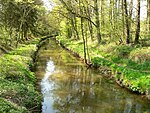
|
03-137 | Weser-Aller lowlands | Gifhorn district | The natural forest consists of three sub-areas and 80% of which are mapped as strongly influenced by groundwater. | position | 39.0 | 1986 |
| Bennerstedt | 03-090 | Elbe valley lowlands | District of Lüneburg | Alder quarry forest, the remnants of a formerly extensive quarry forest complex. In the development area annexed in 2000 in the south into beech-oak forest; also cleared spruce and poplar on some areas. | position | 29.9 | 1987 | |
| Bees kink | 03-113 | Lower Weserbergland and Upper Weser-Leinebergland | Schaumburg district | Small natural forest area with near-natural beech forest on Keuper sites; poor / dry in hilltops, significantly cheaper on slopes, partly heavily pseudo-gleyed, all expositions available; in the valley area, fresh to wet, rich alluvial sites along the Friedrichsburger Bach with near-natural alder-ash forest; artificial pond in the valley area. | position | 17.6 | 1998 | |
| Blütlinger wood |

|
03-027 | Wendland and Altmark | Lüchow-Dannenberg district | Representative natural forest for the alder forests of the Eastern Lower Saxony lowlands, including adjacent transition locations; widespread near-natural red alder stocks, partly with ash, birch and others, in transition areas oak-hornbeam stocks with mixed tree species and often pronounced shrub layers. | position | 84.3 | 1972 |
| Bockmerholz |
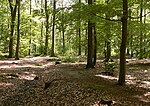
|
03-082 | Lower Saxony Börden | Hanover region | Near-natural deciduous forests on well to very well nutrient-supplied, sustainably fresh to heavily groundwater-influenced sites from Pleistocene cover layers over chalk limestone; Locations strung together like a transect. | position | 41.6 | 1995 |
| Bohldamm | 03-094 | Elbe valley lowlands | District of Lüneburg | Representative natural forest in the groundwater-shaped, mostly fairly well-supplied locations; varied site mosaic due to different degrees of waterlogging, semi-natural mixed deciduous forest stands with an exceptionally high proportion of white elm; on small, slightly elevated "mineral soil islands", the beech can hold itself, in contrast to the surrounding damp locations, which are periodically flooded. | position | 84.8 | 1997 | |
| Bornbruchsmoor | 03-034 | Lueneburg Heath | Gifhorn district | Relatively small natural forest on transitional bog locations with a colorful palette of tree species, almost pure birch forest on some areas. | position | 11.0 | 1972 | |
| Braascher thickness | 03-081 | Lueneburg Heath | Lüchow-Dannenberg district | Old pine stands, mostly loosened up, partly with a considerable admixture of spruce, which rejuvenates together with hardwood, partly loose to dense deciduous-dominated succession with birch, mountain ash, oak etc. a. on a typical sandy location of the East Lower Saxony lowlands; Example of typical pine forest images with spontaneous succession. | position | 47.5 | 1996 | |
| Brakes |

|
03-072 | Stader Geest | District of Stade | Representative example of near-natural deciduous forests on rich sites in the Lower Saxony lowlands that are characterized by groundwater and backwater. | position | 95.9 | 1989 |
| Brambosteler Moor |
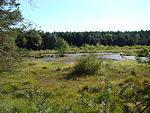
|
03-134 | Lueneburg Heath | District of Uelzen | The area consists of three sub-areas that are more or less heavily marshland and show more or less pronounced changes in location. | position | 11.9 | 1988 |
| fire |

|
03-057 | Weser-Aller lowlands | District of Celle | Example area of an alluvial forest that has been degraded due to major changes in the water balance and is therefore relatively remote from nature; Forest cover in succession. | position | 14.0 | 1974 |
| Bruchberg (NP) |
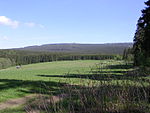
|
03-022 | resin | District of Goslar | Hochmontaner spruce forest with wool. Riding grass; predominantly patchy, unevenly grown spruce, occasionally birch and mountain ash; Area interspersed with unwooded raised bog areas; The western edge collapsed flat. | position | 77.4 | 1972 |
| Bruchwald near Ehrenburg |

|
03-136 | Dümmer Geest lowlands and Ems-Hunte-Geest | District of Diepholz | Low to transitional bog locations with a mixture of tree species, including beech, corresponding to the location. However, the early bird cherry, which is otherwise typical of degenerate floodplain and swamp forest locations, is missing. Renaturation by damming the main drainage ditches since 1992. The long-standing drainage has already resulted in considerable peat subsidence and mineralization with corresponding stilt roots. The high proportion of dead wood in the area is possibly related to the disturbed water balance. At least in parts it is also about meadow afforestation. Not a historically old forest location. | position | 10.7 | 1987 |
| Mountains of bulls | 03-103 | Lueneburg Heath | Heidekreis district | Pine pioneer forest in a relatively early stage of development compared to the neighboring Ehrhorn dunes with beginning or even missing deciduous wood succession. | position | 83.9 | 1992 | |
| Burckhardt | 03-013 | Lower Weserbergland and Upper Weser-Leinebergland | Northeim district | First official natural forest reserve in Lower Saxony; Example of beech forests on dry red sandstone knolls, here z. Partly still planted with sessile oak. | position | 17.0 | 1969 | |
| Burckhardtshöhe |
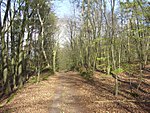
|
03-063 | Dümmer Geest lowlands and Ems-Hunte-Geest | District of Nienburg / Weser | Typical example of the beech forests on fairly well nutrient-supplied, sustainably fresh and partly pseudo-gleyed sites made of boulder clay with a different sand loess cover; the few still existing common oaks are overgrown by the much younger beech. | position | 21.8 | 1974 |
| Butterberg | 03-074 | Weser-Aller lowlands | District of Helmstedt | Representative example of typical beech forests in medium-sized locations with different clay underlay and the resulting pseudo-gleying in the continental part of the north-west German mountain threshold; Conifer-embossed tillering connected to the edge. | position | 59.7 | 1993 | |
| Cananohe |

|
03-059 | Weser-Aller lowlands | Hanover region | Small natural forest with sand-covered boulder clay sites; hornbeam-oak stock, which used to be considered natural, stagnates on a typical beech site; typical example of anthropogenic oak and hornbeam forests. | position | 11.4 | 1974 |
| Dreyberg | 03-087 | Lower Weserbergland and Upper Weser-Leinebergland | Northeim district | Representative example of submontane beech forests on red sandstone in Solling; represent all expositions. | position | 85.4 | 1994 | |
| Drievorden | 03-093 | Dümmer Geest lowlands and Ems-Hunte-Geest | County of Grafschaft Bentheim | Representative example of sand sites in the western lowlands that are heavily influenced by groundwater and poorly supplied with nutrients. Stocking from first afforestation, not an old forest site. The area is criss-crossed by old drainage ditches that are gradually falling into disrepair. | position | 36.8 | 1994 | |
| Dwergter sand | 03-108 | Dümmer Geest lowlands and Ems-Hunte-Geest | District of Cloppenburg | The area represents the poor sandy sites in the high Pleistocene of the growth area of the Lower Saxony coastal area; predominantly old pine stands with deciduous succession approach. | position | 35.9 | 1997 | |
| Corner slope (NP) | 03-088 | resin | District of Goslar | Ecker steep slope exposed to the east with changing location features at 480-560 m above sea level. NN; Hainsimsen-beech forest alternating with maple-ash-beech canyon forest with moon viole; Forest stands torn up by the effects of storms, already high proportions of dead wood and changing structures. | position | 17.8 | 1990 | |
| harrow | 03-139 | Lower Weserbergland and Upper Weser-Leinebergland | Schaumburg district | Parent rock corallenoolite. The entire natural forest does not have a compact shape, but rather a linear expression along steep upper slope areas. | position | 37.3 | 1998 | |
| Ehrhorn dunes |
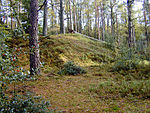
|
03-035 | Lueneburg Heath | Heidekreis district | Sand dunes that were blown up during the forest desolation period with spontaneous, primarily progressive forest development after initial pine planting around 200 years ago. | position | 71.1 | 1972 |
| Eternal route |

|
03-080 | Lueneburg Heath | Lüchow-Dannenberg district | Representative example of near-natural beech forests on a typical sandy site in the low-precipitation part of the east Lower Saxony lowlands; a few oaks and some softwood mixed in; Parallel example to the Lüßberg natural forest in the precipitation-rich part of the growth area. | position | 41.0 | 1996 |
| Fahrberg | 03-092 | Lower Weserbergland and Upper Weser-Leinebergland | Holzminden district | Southern slope with intensive interlinking of lime, loess and flame marl locations in the Hils. | position | 26.1 | 1989 | |
| Forellenbachtal |
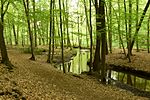
|
03-101 | Lueneburg Heath | District of Uelzen | Transitional area from the azonal forest community to the zonal forest community. Currently with oak, e.g. T. red oak and spruce planted. | position | 37.6 | 1990 |
| Franzhorn | 03-002 | Stader Geest | Rotenburg (Wümme) district | Varied natural forest area in which boulder clay sites, sand sites and Lauenburg clay are combined, pronounced small relief, mixed stands embossed with beech or oak, at the edge pine stand with deciduous succession and small-scale young spruce stands; historically old forest location. | position | 41.8 | 1972 | |
| Peace wood |
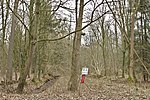
|
03-053 | Ems-Hase-Hunte-Geest | District of Oldenburg | Interesting example of mixed deciduous forests with a change in tree species composition due to use-related changes in groundwater-influenced, fairly well-nutrient-supplied boulder clay sites. Border area for the beech due to the groundwater level and irregular periodic overflow. | position | 14.3 | 1974 |
| Friedrichshaus Bruch | 03-042 | Lower Weserbergland and Upper Weser-Leinebergland | Northeim district | Birch quarry forest in the decay phase on bog locations with partially disturbed water balance, spruce widespread. | position | 26.2 | 1972 | |
| Foxholes | 03-052 | Lower Weserbergland and Upper Weser-Leinebergland | District of Göttingen | Representative example of the shell limestone demolition edges above red clay in the mountainous region of southern Lower Saxony. Moved terrain, already high proportions of dead wood in the area of the demolition edge. | position | 26.9 | 1974 | |
| Gaim |

|
03-100 | Lower Saxony Börden | Hanover region | Rich boulder clay locations with strong groundwater influence and near-natural characteristics of the hornbeam-pedunculate oak forest. | position | 20.6 | 2004 |
| Goehrder oaks |
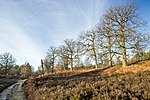
|
03-025 | Lueneburg Heath | Lüchow-Dannenberg district | Entire area part of the NSG Breeser Grund (VO of April 10, 1985). | position | 2.0 | 1972 |
| Grasborner Bruch | 03-043 | Lower Weserbergland and Upper Weser-Leinebergland | Northeim district | Small-scale example of the mixed deciduous forests in the Solling, predominantly on locations that are characterized by water and that accompany the stream. | position | 10.8 | 1972 | |
| Great Freeden |
 more pictures |
03-012 | Lower Weserbergland and Upper Weser-Leinebergland | District of Osnabrück | Elongated limestone ridges with slopes overlaid with loess in all expositions; the only natural forest in the Teutoburg Forest. | position | 41.3 | 1972 |
| Great Staufenberg |
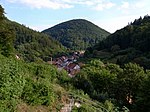
|
03-017 | resin | District of Osterode am Harz | Representative example of typical beech forests in medium and better locations in the transition from the submontane to the montane level of the southern Harz, all expositions are combined in the area. | position | 49.7 | 1972 |
| Large gable moor |

|
03-010 | Weser-Aller lowlands | Gifhorn district | In the original natural forest reserve (approx. 24 ha) Erlenbruchwald u. Alder-ash forest. Here also the lush development of the early blooming bird cherry. In the expansion area in the east, alder stocks from planting with elm, ash and near-natural shrub vegetation. In the west structurally rich birch break forest with high proportions of dead wood, e.g. T. with oak; here also a gray alder population. | position | 121.6 | 1972 |
| Hagen | 03-096 | Wendland and Altmark | Lüchow-Dannenberg district | For decades without forest management; Mostly come into state ownership through land consolidation. Historically old forest with a large variety of spring geophytes. Components of the natural forest are also fallow meadows, willow swamp forests and sedges. The entire space is affected by drainage and land consolidation. | position | 65.5 | 1997 | |
| Hagental | 03-138 | Lower Weserbergland and Upper Weser-Leinebergland | Holzminden district | Spring moor in the middle of a small valley basin. The proportion of birch trees has apparently been reduced by previous thinning. | position | 3.2 | 1989 | |
| Hahnenkleeklippen (NP) |

|
03-021 | resin | District of Goslar | Northern partial area: steep to rugged western slope with scree slopes, 550-750 m above sea level. NN, planted with spruce, some sycamore maple and other hardwood, partly without trees. Southern part of the area: steep to rugged western slope, 550-750 m above sea level. NN, planted with the highest closed beech stand of the western Harz. | position | 29.6 | 1972 |
| Grove |
|
03-201 | Lower Weserbergland and Upper Weser-Leinebergland | District of Osterode am Harz | The only area to represent the Gipskarst locations in southern Lower Saxony. | position | 54.7 | 2004 |
| Haringer Berg | 03-049 | Lower Weserbergland and Upper Weser-Leinebergland | District of Goslar | Oak-hornbeam-beech mixed deciduous forest as the result of earlier medium-sized forest management on the site of the lime-beech forest; very heavy browsing by mouflon deer. | position | 18.8 | 1972 | |
| Harz ancient spruce (NP) | 03-038 | resin | District of Goslar | Hochmontaner spruce forest with wool. Riding grass; Stocking is partly formed by spruce that is probably more than 250 years old, hardwood is very rare; some unwooded raised bog areas; Stocking has become significantly lighter and dying in recent years. | position | 30.0 | 1972 | |
| Hit and Bark | 03-079 | Dümmer Geest lowlands and Ems-Hunte-Geest | District of Diepholz | Mixed beech stands on mighty sand loess sites; emerged from reforestation of hacked-out areas - so-called Erdmann stocks - and subsequent intensive forest care. There is a tendency for the late blooming bird cherry to immigrate. | position | 33.2 | 1998 | |
| Heinsener cliffs |

|
03-085 | Lower Weserbergland and Upper Weser-Leinebergland | Holzminden district | Natural forest cut like fringes, which covers steep slopes and hilltops as special locations on a larger area, which otherwise only occur in small areas. | position | 63.0 | 1986 |
| Herrenholz |

|
03-003 | Dümmer Geest lowlands and Ems-Hunte-Geest | District of Vechta | Natural forest area with richer glacial till such as Lauenburg clay sites, partly covered with sand loess; Mixed hardwood stocks of beech, English oak, hornbeam, in different forms; the area includes the Herrenholz primeval forest, an approx. 1.6 hectare forest parcel with mighty oaks and beeches and an abundance of holly undergrowth. | position | 21.2 | 1972 |
| Hohenstein |

|
03-051 | Lower Weserbergland and Upper Weser-Leinebergland | Hameln-Pyrmont district | Entire area part of the Hohenstein NSG (Regulation of February 23, 1972), of paramount importance for species protection. | position | 58.9 | 1972 |
| Chicken tunnel |
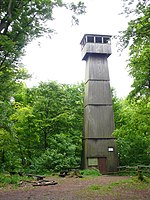
|
03-014 | Lower Weserbergland and Upper Weser-Leinebergland | District of Göttingen | Representative example of rich mixed deciduous forests on a typical sequence of locations in the mountainous region of southern Lower Saxony. | position | 56.2 | 1972 |
| Huntebruch |

|
03-078 | Dümmer Geest lowlands and Ems-Hunte-Geest | District of Diepholz | Flat fen sites with near-natural tree species composition; Isolated forest place in the Feldmark with considerable marginal influences. | position | 36.5 | 1976 |
| Ihlow |

|
03-062 | East Frisian-Oldenburg Geest | Aurich district | Natural forest close to the coast on sand sites influenced by reservoirs and groundwater with loam underlay; Mixed stands of beech and oak, crowns already exposed to wind chopping, in the north alder and ash forest; Location with Esch edition, discounts. Historically disturbed old forest site. | position | 22.0 | 1974 |
| Junkerwerder |
 
|
03-116 | Elbe valley (at the transition to the Lüneburg Heath) | Lüchow-Dannenberg district | The natural forest is part of an almost 30 hectare forest in the flooded area of the Elbe. Probably the most natural and structurally rich hardwood alluvial forest in Lower Saxony. Well-supplied, sandy floodplain sediments on the banks of the Elbe; regular, natural floodplain dynamics. Ice drift with corresponding damage to the logs can occur. Historically old forest, with development that was barely influenced for a long time. Species-rich, typical floodplain vegetation. | position | 7.0 | 2000 |
| Kaarßer sand mountains |

|
03-095 | Elbe valley lowlands | District of Lüneburg | Representative example of pine forests on the poorest, dry dune sands in the north German lowlands; single-layer, dull-growing pine stands, predominantly of older age, deciduous rejuvenation and successional approach hardly recognizable. | position | 83.8 | 1998 |
| Cat building | 03-091 | Lower Weserbergland and Upper Weser-Leinebergland | Holzminden district | Representative example of the beech forests in the Hils on mostly fairly well nutrient-supplied, differently loess-influenced flame marl sites, in the eastern part Hilssandstein, partly as loess-influenced floating soil; due to the presence of all expositions and moving terrain relief varied site mosaic; Beech stands combined with mixed tree species in different age groups in the area. | position | 109.0 | 1989 | |
| Kiekenbruch | 03-033 | Lueneburg Heath | Gifhorn district | Remains of 200-year-old pine with younger pine, spruce and common oak; in the lower stand layers, shrub layer and rejuvenation, additional mountain ash, birch, willow; Particularly characterized by high amounts of lying and standing dead wood as well as special tree shapes. | position | 5.0 | 1972 | |
| Kienmoor |

|
03-007 | Weser-Aller lowlands | Hanover region | Relatively small natural forest on transitional bog locations. Old pines possibly autochthonous, confirmation of the autochthony of the spruce has not yet been possible, but spruce mainly from approach. | position | 16.6 | 1972 |
| Kistenberg |

|
03-098 | East Frisian-Oldenburg Geest | District of Oldenburg | Rare example of a larger closed forest area that was not afforested again after the storm wood was removed. | position | 17.8 | 1997 |
| Small gable moor |

|
03-150 | Weser-Aller lowlands | Gifhorn district | The peculiarity of the area lies in the fact that wood has not been used for several decades (but the exact year is not known) and in the decaying phase of the oldest moor birch that can be observed here. | position | 38.4 | 2002 |
| King beech | 03-046 | Lower Weserbergland and Upper Weser-Leinebergland | District of Osterode am Harz | Typical example of the beech forests on Lower Buntsandstein in the Harz foreland. | position | 28.0 | 1972 | |
| Kuxberg | 03-097 | Northern Harz foreland | Wolfenbüttel district | Representative example of the mixed beech forests on richer locations, in the clearly sub-continental part of the “Northwest German Berglandschwelle”; Locations typically made of shell limestone influenced by loess; varied relief, all expositions available, varied site mosaic. | position | 55.4 | 1997 | |
| Landwehr (Pretzetzer Landwehr) |

|
03-026 | Wendland and Altmark | Lüchow-Dannenberg district | Representative natural forest for the groundwater-influenced, better nutrient-supplied sand locations of the East Lower Saxony lowlands; Forest stands still largely characterized by English oak and hornbeam, with a clear successive tendency towards more beech participation. | position | 101.4 | 1972 |
| Long walls | 03-111 | Lower Weserbergland and Upper Weser-Leinebergland | Schaumburg district | Representative example of an extensive limestone cliff, embedded in the typically coherent site mosaic with gently sloping slope, rock ridge and gradually eroding slope foot locations; Depending on the location, mixed stands of beech trees that grow dull to young. | position | 34.0 | 1997 | |
| Limker strand | 03-044 | Lower Weserbergland and Upper Weser-Leinebergland | Northeim district | Typical example of submontane beech forests in Solling with regeneration dynamics in stand gaps. | position | 20.5 | 1972 | |
| wage |

|
03-058 | Lueneburg Heath | District of Uelzen | Representative example of beech forests on rich sites with glacial till (here with sand loess overlay). | position | 37.1 | 1974 |
| Luhden cliffs |
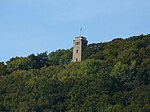
|
03-140 | Lower Weserbergland and Upper Weser-Leinebergland | Schaumburg district | Parent rock corallenoolite. Small natural forest in an elongated shape; Rock area with adjacent steep upper slope. | position | 5.8 | 1998 |
| Luessberg |

|
03-030 | Lueneburg Heath | District of Celle | Rare, near-natural old beech trees on a typical sandy site in the rainier part of the East Lower Saxony lowlands, oak admixtures anthropogenically promoted; Parallel example to the natural forest Eternal route in the low-precipitation part of the growth area. | position | 29.1 | 1974 |
| Maaßel |
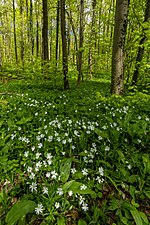
|
03-008 | Weser-Aller lowlands | Gifhorn district | Forest coverings made up of pedunculate oak and hornbeam, which have been modified due to use, on a boulder clay site that is clearly characterized by backwater, above chalk lime in the deep subsoil, relatively continental climatic area. | position | 11.9 | 1972 |
| Mesh break | 03-135 | Lueneburg Heath | District of Uelzen | As the core zone of a nature reserve, the Maschbruch natural forest fulfills important functions for species and biotope protection. | position | 6.6 | 1994 | |
| Meinsberg |
 more pictures |
03-060 | Lower Weserbergland and Upper Weser-Leinebergland | Hanover region | Representative natural forest for the richer, loess-influenced Jurassic limestone locations, including partial areas with a thick loess cover and the Münder marl in the Atlantic western part of the Lower Weser-Leine mountainous region, as well as a typical beech forest area for the richer locations in the southern part of the Deister; by far predominantly natural beech old stocks, supplemented by a rejuvenated beech area with overhang. | position | 65.1 | 1971 |
| Meninger wood | 03-076 | Lueneburg Heath | Harburg district | Representative natural forest with occurrences of typical growth area locations and alternating stand structures. | position | 68.3 | 1986 | |
| Mittelberg (NP) | 03-106 | resin | District of Osterode am Harz | Representative example of typical, mostly moderately supplied locations in the submontane level of the Harz with all exposures; Beech and spruce stocks, pure and mixed, in different ages. | position | 123.7 | 1996 | |
| Middle Ith |

|
03-084 | Lower Weserbergland and Upper Weser-Leinebergland | Holzminden district | Small natural forest with a wet, soaky special location in the center. | position | 13.7 | 1987 |
| Mühlenberg (NP) | 03-105 | resin | District of Osterode am Harz | Representative example of the grove beech forests in the submontane level of the Harz on somewhat better-supplied locations, in all expositions, reaching up to the montane level; large areas of almost pure beech forests of different ages. | position | 254.5 | 1996 | |
| New forest | 03-109 | Weser-Aller lowlands | District of Nienburg / Weser | Representative natural forest for the poor, dry sandy locations in the high Pleistocene of the growth area of the Central-West Lower Saxony lowlands; predominantly old pine stands with groups of beeches, widespread deciduous succession tendencies; not a historically old forest location. | position | 53.5 | 1997 | |
| Neuchâtel jungle |

|
03-071 | East Frisian-Oldenburg Geest | District of Friesland | "Primeval forest" area known throughout Europe with mighty pedunculate oaks, hornbeams, beeches, etc. a., as relics of earlier forms of forest use on well-nutrient-supplied backwater-affected sites made of covered Lauenburg clay; Forest image characterized by mighty trees, a lot of strong, standing and lying dead wood with partly dense undergrowth of holly. | position | 59.0 | 1990 |
| Nordahner wood |

|
03-001 | Stader Geest | District of Cuxhaven | Mixed deciduous forest made of beech, English oak, hornbeam and the like a. in varying proportions, depending on the water balance, different beech participation, on boulder clay locations with different levels of backwater influence. Old forest soil with the occurrence of rare soil plants, small forest village, isolated in the middle of agricultural areas. | position | 19.2 | 1972 |
| Or slope | 03-047 | resin | District of Osterode am Harz | North exposed, richer, z. Partly soaky slope in the submontane zone of the southern Harz. | position | 16.6 | 1972 | |
| Horse crib | 03-104 | Lower Weserbergland and Upper Weser-Leinebergland | District of Göttingen | Example of small-scale mixed beech forests on dry, skeletal, steep limestone sites. | position | 18.1 | 1989 | |
| Giant mountain |

|
03-055 | Northern Harz foreland | District of Helmstedt | Due to the intensive use of pasture, mast and firewood, the tree species combination of a potential pearl grass beech forest has been greatly changed. | position | 19.0 | 1974 |
| Cattle pasture | 03-037 | Lower Weserbergland and Upper Weser-Leinebergland | Hameln-Pyrmont district | Numerous spring outlets characterize the cattle pasture and lead to the development of a spring, alder and ash forest. | position | 3.4 | 1972 | |
| Ringelah | 03-115 | Weser-Aller lowlands | Gifhorn district | Heterogeneous stand mosaic from stands of different ages with oak, birch, pine and spruce, e.g. T. from planted crops. | position | 42.9 | 1999 | |
| Saubrink / Oberberg |
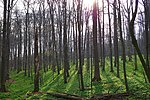
|
03-083 | Lower Weserbergland and Upper Weser-Leinebergland | Hameln-Pyrmont district | Lime, loess and steep slope special sites with complete site mosaic in close interlinking: different stand compositions, stand ages and structures; largest natural forest in Lower Saxony, an area of great cultural and historical significance. | position | 245.0 | 1986 |
| Schlenke | 03-029 | Weser-Aller lowlands | Heidekreis district | Rare remnants of floodplain forests; is flooded in spite of the dike in extreme floods; Dike relocation remains necessary to restore a 'real' alluvial forest site. | position | 40.8 | 1972 | |
| Schmidt's pines |
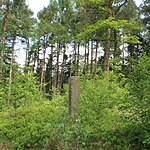
|
03-102 | Stader Geest | Osterholz district | Rare example of a spontaneous pioneer forest succession in a larger sand mining area, surrounded by forest stands in which all tree species relevant to the succession are represented; older pioneer forest stands have been developing for about 20 years, forest expansion followed the progress of mining, so that different pioneer forest phases occur side by side. | position | 17.2 | 1997 |
| Schrabstein | 03-061 | Lower Weserbergland and Upper Weser-Leinebergland | Hameln-Pyrmont district | South-facing limestone rock face with subsequent limestone scree field with characteristic mixed deciduous forest cover, dry-warm limestone locations made of beech with added service tree, maple species, summer linden and various types of shrub. South-facing slope, plateau area and deeply incised Kerbtal form a diverse site mosaic. | position | 22.4 | 1974 | |
| Sonnenberger Moorwald (NP) | 03-040 | resin | District of Goslar | Hochmontaner spruce forest as a typical high moor spruce forest in the Sonnenberger Moor on the Edaphic tree line; the area includes forest-free raised bog areas. | position | 65.4 | 1972 | |
| Sonnenkopf (NP) | 03-039 | resin | District of Osterode am Harz | (Upper) Montaner beech-spruce forest on an eastern slope in the upper Siebertal, reaching up to approx. 700 m; Old spruce trees with mixed beech trees of the same age, occasional sycamore maple. | position | 33.1 | 1972 | |
| Holly forest | 03-036 | Lueneburg Heath | Harburg district | The stock picture is explained by very strong interventions in an old beech stock towards the end of the 1960s and also immediately before the designation of the reserve in 1972. The blows and subsequent windthrow in the torn stock led to a large clearing and as a result to an explosive development of the well already present in the shelter Ilex. Partial areas where Ilex was missing are still recognizable today as bracken gaps. The lush ilex development is also probably due to favorable micro-climatic conditions, as the population on the western edge is in a clearly raised terrain with a corresponding windward effect. | position | 5.5 | 1972 | |
| Steinbrink |
 more pictures |
03-110 | Lower Weserbergland and Upper Weser-Leinebergland | Hanover region | Representative example of typical species-poor beech forests on mostly moderately supplied Wealden sandstone soils with different loess influences in the Atlantic north-western part of the Lower Weser-Leine mountainous region, as well as a typical beech forest area for the poorer locations in the northern part of the Deister; moving, varied terrain relief; by far predominantly near-natural beech stands in mostly loosened stands. | position | 40.9 | 1997 |
| Browsing shark |
|
03-019 | resin | District of Osterode am Harz | Highest old beech stand in the western Harz on the border to the Upper Montane level. | position | 14.6 | 1972 |
| Battlefield | 03-107 | East Frisian-Oldenburg Geest | District of Friesland | The area represents the poor sand locations with groundwater influence of the growth area of the Lower Saxony coastal area; Old pine stands with deciduous succession; not a historically old forest location. | position | 28.8 | 1997 | |
| Sweet | 03-077 | Lueneburg Heath | District of Uelzen | Typologically and geographically very varied natural forest, predominantly on clay loam sites with different layers of bedrock sand; very different stand ages and tree species mixtures exist. | position | 64.5 | 1996 | |
| Totenberg |

|
03-086 | Lower Weserbergland and Upper Weser-Leinebergland | District of Göttingen | Representative example of typical beech forests on red sandstone locations in the mountainous region of southern Lower Saxony outside of Solling. | position | 87.0 | 1989 |
| Tüxen area | 03-005 | Lueneburg Heath | District of Uelzen | Moderately dry, weak sandy location; Stocking as the result of an attempt 50 years ago to establish a birch-oak forest, no action has been taken since then. | position | 12.1 | 1972 | |
| Jungle tree path |

|
03-075 | Dümmer Geest lowlands and Ems-Hunte-Geest | District of Cloppenburg | Remnants of an oak, Hute and Kratt forest, the use of which was given up in the last century; Forest images characterized by "primeval" tree shapes; Succession to beech-rich forest coverings is still in a comparatively early stage (shrub layer); high stocks of dead wood, high proportion of "special tree shapes". | position | 37.5 | 1998 |
| Hasbruch jungle |

|
03-099 | Dümmer Geest lowlands and Ems-Hunte-Geest | District of Oldenburg | position | 38.9 | 1974 | |
| Vogelherd |

|
03-041 | Lower Weserbergland and Upper Weser-Leinebergland | Holzminden district | Small-scale example of the beech forests of the Hochsolling. | position | 10.8 | 1972 |
| Walbeck control room |
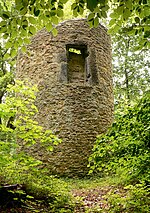
|
03-011 | Weser-Aller lowlands | District of Helmstedt | Typical example of use-related modified forest cover on heavy clay soils in the continental part of the north-west German Berglandschwelle. The aim of the observation is the competitiveness of the beech against the oak under the special site conditions. | position | 51.1 | 1972 |
| Wehdenbruch |

|
03-133 | Stader Geest | District of Cuxhaven | A largely dissolved moor birch-spruce mixed stand, including natural regeneration of predominantly downy birch, some rowan and occasional buckthorn, spruce, sitka spruce, pedunculate oak and late bloom. Bird cherry. The entire area is criss-crossed with old trenches. | position | 8.8 | 1985 |
| Weichel | 03-073 | Stader Geest | Rotenburg (Wümme) district | Representative example of the beech forests of the lowlands on boulder clay sites with bed load sand overlay. | position | 31.6 | 1986 | |
| Weser steep slopes | 03-112 | Lower Weserbergland and Upper Weser-Leinebergland | Northeim district | A characteristic example of the steep slopes of the Weser including side valleys on the Solling rim; Red sandstone weathered soils with loess influence, significantly better nutrient supply on some areas; Mixed beech stands, widespread with the addition of coniferous wood, especially larch, next to spruce and some pine; in the western part mostly young stocks. | position | 90.8 | 1997 | |
| Winterlieth | 03-089 | Lower Weserbergland and Upper Weser-Leinebergland | Northeim district | position | 98.6 | 1994 | ||
| Wittenheim | 03-114 | East Frisian-Oldenburg Geest | Ammerland district | Near-natural tillering with ash, alder, oak, elm, sycamore and linden. Well-developed shrub layer with early flowering bird cherry, eu cone and hazel. | position | 12.8 | 1998 |
See also
- List of nature reserves in Lower Saxony
- List of landscape protection areas in Lower Saxony
- List of FFH areas in Lower Saxony
- List of EU bird protection areas in Lower Saxony
Individual evidence
- ↑ naturwaelder.de, database of natural forest reserves in Germany, Lower Saxony
- ↑ naturwaelder.de, overviews of the areas of the NWR - status: 24.11.2016